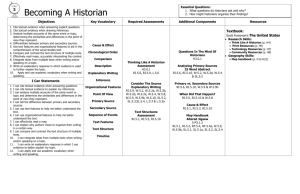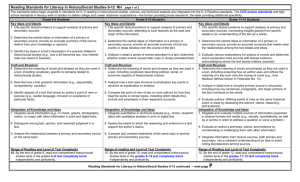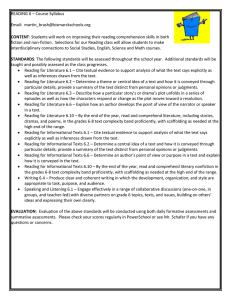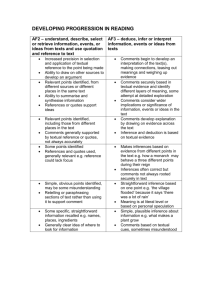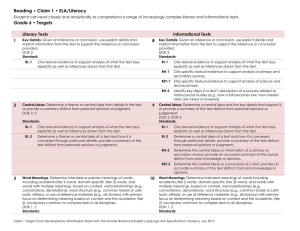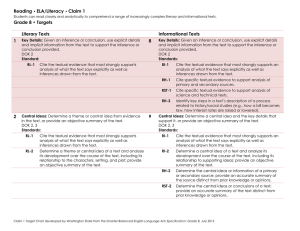ELA Grade 7 Claim 1 Targets (long version)
advertisement
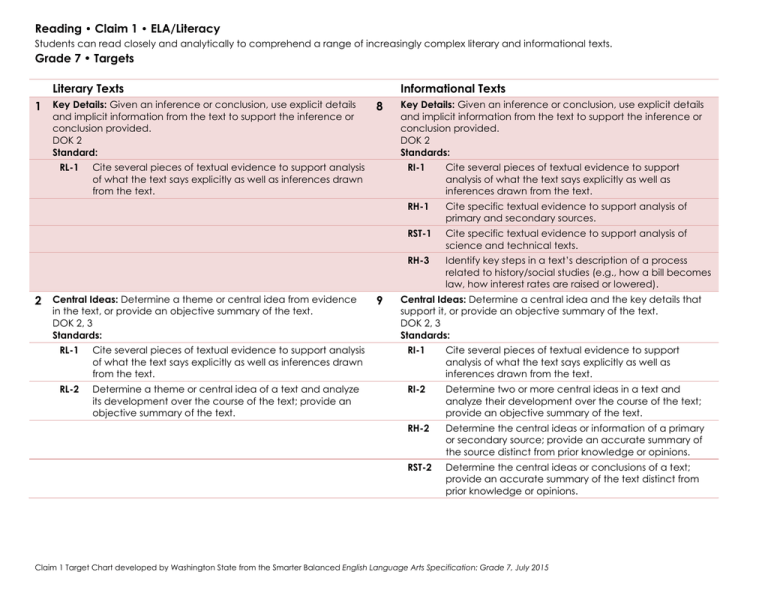
Reading • Claim 1 • ELA/Literacy Students can read closely and analytically to comprehend a range of increasingly complex literary and informational texts. Grade 7 • Targets Literary Texts 1 Key Details: Given an inference or conclusion, use explicit details and implicit information from the text to support the inference or conclusion provided. DOK 2 Standard: RL-1 Informational Texts 8 Cite several pieces of textual evidence to support analysis of what the text says explicitly as well as inferences drawn from the text. 2 Central Ideas: Determine a theme or central idea from evidence in the text, or provide an objective summary of the text. DOK 2, 3 Standards: 9 Key Details: Given an inference or conclusion, use explicit details and implicit information from the text to support the inference or conclusion provided. DOK 2 Standards: RI-1 Cite several pieces of textual evidence to support analysis of what the text says explicitly as well as inferences drawn from the text. RH-1 Cite specific textual evidence to support analysis of primary and secondary sources. RST-1 Cite specific textual evidence to support analysis of science and technical texts. RH-3 Identify key steps in a text’s description of a process related to history/social studies (e.g., how a bill becomes law, how interest rates are raised or lowered). Central Ideas: Determine a central idea and the key details that support it, or provide an objective summary of the text. DOK 2, 3 Standards: RL-1 Cite several pieces of textual evidence to support analysis of what the text says explicitly as well as inferences drawn from the text. RI-1 Cite several pieces of textual evidence to support analysis of what the text says explicitly as well as inferences drawn from the text. RL-2 Determine a theme or central idea of a text and analyze its development over the course of the text; provide an objective summary of the text. RI-2 Determine two or more central ideas in a text and analyze their development over the course of the text; provide an objective summary of the text. RH-2 Determine the central ideas or information of a primary or secondary source; provide an accurate summary of the source distinct from prior knowledge or opinions. RST-2 Determine the central ideas or conclusions of a text; provide an accurate summary of the text distinct from prior knowledge or opinions. Claim 1 Target Chart developed by Washington State from the Smarter Balanced English Language Arts Specification: Grade 7, July 2015 Reading • Claim 1 • ELA/Literacy Students can read closely and analytically to comprehend a range of increasingly complex literary and informational texts. Grade 7 • Targets 3 Word Meanings: Determine intended or precise meanings of words, including academic/tier 2 words, domain-specific (tier 3) words, and words with multiple meanings, based on context, word relationships (e.g., synonyms, antonyms, analogy, connotations, denotations), word structure (e.g., common Greek or Latin roots, affixes), or use of reference materials (e.g., dictionary), with primary focus on determining meaning based on context and the academic (tier 2) vocabulary common to complex texts in all disciplines. DOK 1, 2 Standards: 10 Word Meanings: Determine intended meanings of words including academic/tier 2 words, domain-specific (tier 3) words, and words with multiple meanings, based on context, word relationships (e.g., synonym, antonym, analogy, connotations, denotations), word structure (e.g., common Greek or Latin roots, affixes), or use of reference materials (e.g., dictionary), with primary focus on determining meaning based on context and the academic (tier 2) vocabulary common to complex texts in all disciplines. Gr. 7 DOK 1, 2 Standards: RL-1 Cite several pieces of textual evidence to support analysis of what the text says explicitly as well as inferences drawn from the text. RI-1 Cite several pieces of textual evidence to support analysis of what the text says explicitly as well as inferences drawn from the text. RL-4 Determine the meaning of words and phrases as they are used in a text, including figurative and connotative meanings; analyze the impact of rhymes and other repetitions of sounds (e.g., alliteration) on a specific verse or stanza of a poem or section of a story or drama. RI-4 Determine the meaning of words and phrases as they are used in a text, including figurative, connotative, and technical meanings; analyze the impact of a specific word choice on meaning and tone. L-4 Determine or clarify the meaning of unknown and multiple-meaning words and phrases based on grade 7 reading and content, choosing flexibly from a range of strategies. RH-4 Determine the meaning of words and phrases as they are used in a text, including vocabulary specific to domains related to history/social studies. L-4a Use context (e.g., the overall meaning of a sentence or paragraph; a word’s position or function in a sentence) as a clue to the meaning of a word or phrase. RST-4 Determine the meaning of symbols, key terms, and other domain-specific words and phrases as they are used in a specific scientific or technical context relevant to grades 6–8 texts and topics. L-4b Use common, grade-appropriate Greek or Latin affixes and roots as clues to the meaning of a word (e.g., belligerent, bellicose, rebel). L-4 Determine or clarify the meaning of unknown and multiple-meaning words and phrases based on grade 7 reading and content, choosing flexibly from a range of strategies. L-4c Consult general and specialized reference materials (e.g., dictionaries, glossaries, thesauruses), both print and digital, to find the pronunciation of a word or determine or clarify its precise meaning or its part of speech. L-4a Use context (e.g., the overall meaning of a sentence or paragraph; a word’s position or function in a sentence) as a clue to the meaning of a word or phrase. Claim 1 Target Chart developed by Washington State from the Smarter Balanced English Language Arts Specification: Grade 7, July 2015 Reading • Claim 1 • ELA/Literacy Students can read closely and analytically to comprehend a range of increasingly complex literary and informational texts. Grade 7 • Targets L-4d Verify the preliminary determination of the meaning of a word or phrase (e.g., by checking the inferred meaning in context or in a dictionary). L-4b Use common, grade-appropriate Greek or Latin affixes and roots as clues to the meaning of a word (e.g., belligerent, bellicose, rebel). L-5b Use the relationship between particular words (e.g., synonym/antonym, analogy) to better understand each of the words. L-4c Consult general and specialized reference materials (e.g., dictionaries, glossaries, thesauruses), both print and digital, to find the pronunciation of a word or determine or clarify its precise meaning or its part of speech. L-5c Distinguish among the connotations (associations) of words with similar denotations (definitions) (e.g., refined, respectful, polite, diplomatic, condescending). L-4d Verify the preliminary determination of the meaning of a word or phrase (e.g., by checking the inferred meaning in context or in a dictionary). L-6 Acquire and use accurately grade-appropriate general academic and domain-specific words and phrases; gather vocabulary knowledge when considering a word or phrase important to comprehension or expression. L-5b Use the relationship between particular words (e.g., synonym/antonym, analogy) to better understand each of the words. L-5c Distinguish among the connotations (associations) of words with similar denotations (definitions) (e.g., refined, respectful, polite, diplomatic, condescending). L-6 Acquire and use accurately grade-appropriate general academic and domain-specific words and phrases; gather vocabulary knowledge when considering a word or phrase important to comprehension or expression. 4 Reasoning & Evidence: Make an inference or draw a conclusion about a text OR make inferences or draw conclusions in order to compare texts (e.g., character development, setting, plot, point of view, or fictional portrayal of time, place or character) and use supporting evidence as justification/explanation. DOK 3, 4 Standards: 11 Reasoning & Evidence: Make an inference or draw a conclusion about a text OR make inferences or draw conclusions in order to compare texts (e.g., interaction between individuals, events and ideas; author’s point of view/purpose; use of media or formats; trace and evaluate the argument and specific claims) and use supporting evidence as justification/explanation. DOK 3, 4 Standards: RL-1 Cite several pieces of textual evidence to support analysis of what the text says explicitly as well as inferences drawn from the text. RI-1 Cite several pieces of textual evidence to support analysis of what the text says explicitly as well as inferences drawn from the text. RL-3 Analyze how particular elements of a story or drama interact (e.g., how setting shapes the characters or plot). RI-3 Analyze the interactions between individuals, events, and ideas in a text (e.g., how ideas influence individuals or events, or how individuals influence ideas or events). Claim 1 Target Chart developed by Washington State from the Smarter Balanced English Language Arts Specification: Grade 7, July 2015 Reading • Claim 1 • ELA/Literacy Students can read closely and analytically to comprehend a range of increasingly complex literary and informational texts. Grade 7 • Targets RL-6 Analyze how an author develops and contrasts the points of view of different characters or narrators in a text. RI-6 Determine an author’s point of view or purpose in a text and analyze how the author distinguishes his or her position from that of others. RL-9 Compare and contrast a fictional portrayal of a time, place, or character and a historical account of the same period as a means of understanding how authors of fiction use or alter history. RH-6 Identify aspects of a text that reveal an author’s point of view or purpose (e.g., loaded language, inclusion or avoidance of particular facts). RST-6 Analyze the author’s purpose in providing an explanation, describing a procedure, or discussing an experiment in a text. RI-7 Compare and contrast a text to an audio, video, or multimedia version of the text, analyzing each medium’s portrayal of the subject (e.g., how the delivery of a speech affects the impact of the words). RI-8 Trace and evaluate the argument and specific claims in a text, assessing whether the reasoning is sound and the evidence is relevant and sufficient to support the claims. RH-8 Distinguish among fact, opinion, and reasoned judgment in a text. RST-8 Distinguish among facts, reasoned judgment based on research findings, and speculation in a text. RI-9 Analyze how two or more authors writing about the same topic shape their presentations of key information by emphasizing different evidence or advancing different interpretations of facts. 5 Analysis Within Or Across Texts: Analyze relationships among literary elements (e.g., setting, characters, plot) within or across texts or analyze how an author develops the narrator or characters' point of view within or across texts. DOK 3, 4 Standards: RL-1 Cite several pieces of textual evidence to support analysis of what the text says explicitly as well as inferences drawn from the text. 12 Analysis Within Or Across Texts: Analyze or compare how information is presented within or across texts (e.g. interactions between individuals, events, or ideas) or how information within or across texts reveals author's point of view or purpose. DOK 3, 4 Standards: RI-1 Cite several pieces of textual evidence to support analysis of what the text says explicitly as well as inferences drawn from the text. Claim 1 Target Chart developed by Washington State from the Smarter Balanced English Language Arts Specification: Grade 7, July 2015 Reading • Claim 1 • ELA/Literacy Students can read closely and analytically to comprehend a range of increasingly complex literary and informational texts. Grade 7 • Targets RL-3 Analyze how particular elements of a story or drama interact (e.g., how setting shapes the characters or plot). RI-3 Analyze the interactions between individuals, events, and ideas in a text (e.g., how ideas influence individuals or events, or how individuals influence ideas or events). RL-6 Analyze how an author develops and contrasts the points of view of different characters or narrators in a text. RI-6 Determine an author’s point of view or purpose in a text and analyze how the author distinguishes his or her position from that of others. 6 Text Structures & Features: Analyze text structures and the impact of those choices on meaning or presentation. DOK 2, 3 Standards: 13 Text Structures & Features: Relate knowledge of text structures (e.g. organization of a text) or text features to analyze or compare the impact of those choices on meaning or presentation. DOK 2, 3 Standards: RL-1 Cite several pieces of textual evidence to support analysis of what the text says explicitly as well as inferences drawn from the text. RI-1 Cite several pieces of textual evidence to support analysis of what the text says explicitly as well as inferences drawn from the text. RL-5 Analyze how a drama’s or poem’s form or structure (e.g., soliloquy, sonnet) contributes to its meaning. RI-5 Analyze the structure an author uses to organize a text, including how the major sections contribute to the whole and to the development of the ideas. RH-5 Describe how a text presents information (e.g., sequentially, comparatively, causally). RST-5 Analyze how the text structures information or ideas into categories or hierarchies, demonstrating understanding of the information or ideas. RI-7 Compare and contrast a text to an audio, video, or multimedia version of the text, analyzing each medium’s portrayal of the subject (e.g., how the delivery of a speech affects the impact of the words). 7 Language Use: Interpret and analyze figurative language use (e.g., figurative, connotative meanings) or demonstrate understanding of nuances in word meanings used in context and the impact of those word choices on meaning and tone. DOK 3 Standards: RL-1 Cite several pieces of textual evidence to support analysis of what the text says explicitly as well as inferences drawn from the text. 14 Language Use: Interpret understanding of figurative language, word relationships, nuances of words and phrases, or figures of speech (e.g., literary, mythological allusions) used in context and the impact of those word choices on meaning. DOK 3 Standards: RI-1 Cite several pieces of textual evidence to support analysis of what the text says explicitly as well as inferences drawn from the text. Claim 1 Target Chart developed by Washington State from the Smarter Balanced English Language Arts Specification: Grade 7, July 2015 Reading • Claim 1 • ELA/Literacy Students can read closely and analytically to comprehend a range of increasingly complex literary and informational texts. Grade 7 • Targets RL-4 Determine the meaning of words and phrases as they are used in a text, including figurative and connotative meanings; analyze the impact of rhymes and other repetitions of sounds (e.g., alliteration) on a specific verse or stanza of a poem or section of a story or drama. L-5 Demonstrate understanding of figurative language, word relationships, and nuances in word meanings. L-5 Demonstrate understanding of figurative language, word relationships, and nuances in word meanings. L-5a Interpret figures of speech (e.g., literary, biblical, and mythological allusions) in context. L-5a Interpret figures of speech (e.g., literary, biblical, and mythological allusions) in context. Claim 1 Target Chart developed by Washington State from the Smarter Balanced English Language Arts Specification: Grade 7, July 2015
